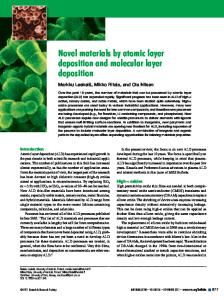Plasma Enhanced Atomic Layer Deposition of ZrO 2 Gate Dielectric
- PDF / 130,004 Bytes
- 6 Pages / 595 x 842 pts (A4) Page_size
- 39 Downloads / 443 Views
Plasma Enhanced Atomic Layer Deposition of ZrO2 Gate Dielectric Jaehyoung Koo, Jiwoong Han, Sungwoo Choi, Chan Gyung Park*, Yangdo Kim and Hyeongtag Jeon Division of Materials Science and Engineering, Hanyang Univ. Seoul 133-791, Korea *Department of Materials Science and Engineering, Pohang University of Science and Technology (POSTECH), Pohang 790-784, Korea ABSTRACT Zirconium oxide (ZrO2) films were investigated as a potential replacement for silicon dioxide gate dielectric. ZrO2 films were deposited by both atomic layer deposition (ALD) and plasma enhanced ALD (PEALD) techniques using Zr t-butoxide and Zr(NEt2)4 as Zr precursors and oxygen as reactant gas. The XTEM images showed a randomly oriented polycrystalline structure of ZrO2 and amorphous characteristics of the interfacial layer. The calculated dielectric constant value of the ZrO2 films are about 10∼18 and these low values are believed due to the low dielectric constant interface layer. ZrO2 films deposited with oxygen plasma using Zr(NEt2)4 showed the leakage current of 3.12×10-9 A/cm2 at the gate bias voltage of -1.0 Volt with the equivalent oxide thickness value of 1.39 nm. ZrO2 films deposited with the oxygen plasma showed generally improved film quality with relatively low leakage current, small hysteresis and low carbon incorporation as well as the higher growth rate compared to the films deposited with the oxygen gas. Also, ZrO2 films deposited using Zr(NEt2)4 showed relatively improved film properties compared to the films deposited using Zr t-butoxide. This study demonstrated the possible application of PEALD technique for the high quality ZrO2 gate dielectric film deposition. INTRODUCTION Silicon oxide (SiO2), most commonly used as gate oxide due to the large band gap, thermal and chemical stability, high quality Si-SiO2 interface properties and superior reliability, will face the new serious problem of the physical thickness limit which results in the high tunneling leakage current as the device dimensions scaled down to the nano-scale level1. To prevent this phenomenon and achieve a low leakage current at the same equivalent oxide thickness (EOT), high dielectric constant oxides were investigated as alternative gate oxide in advanced metal oxide semiconductor (MOS) devices2. Among the several candidate materials, zirconium oxide (ZrO2) has been predicted to be thermodynamically stable in contact with silicon and expected to have compatible gate oxide properties3. ZrO2 has a relatively high dielectric constant (~25), wide band gap (5.8 eV) and compatibility with the manufacturing of integrated circuits4-8. In addition, excellent electrical properties of ZrO2 films by process optimization have recently been reported9. For these reasons, many researches have been launched out in recent years to investigate the B2.1.1 Downloaded from https:/www.cambridge.org/core. Columbia University Libraries, on 06 Jul 2017 at 12:46:38, subject to the Cambridge Core terms of use, available at https:/www.cambridge.org/core/terms. https://doi.org/10.1557/PROC-716
Data Loading...










